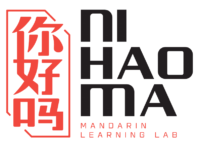Chinese attributive modifiers are an important grammatical component that modify nouns, adding extra information to make sentences clearer and more precise. If you are learning Chinese or want to improve your ability to express yourself, understanding and using attributives correctly is essential.
So, what exactly is an attributive, and how do you use it? Let’s explore this topic together with Ni Hao Ma in the article below!
What are Chinese attributive modifiers?
In Chinese, an attributive modifier (定语 – dìngyǔ) is a modifier that describes or qualifies a noun or noun phrase, helping to clarify its characteristics, attributes, quantity, or its relationship to other elements in the sentence.
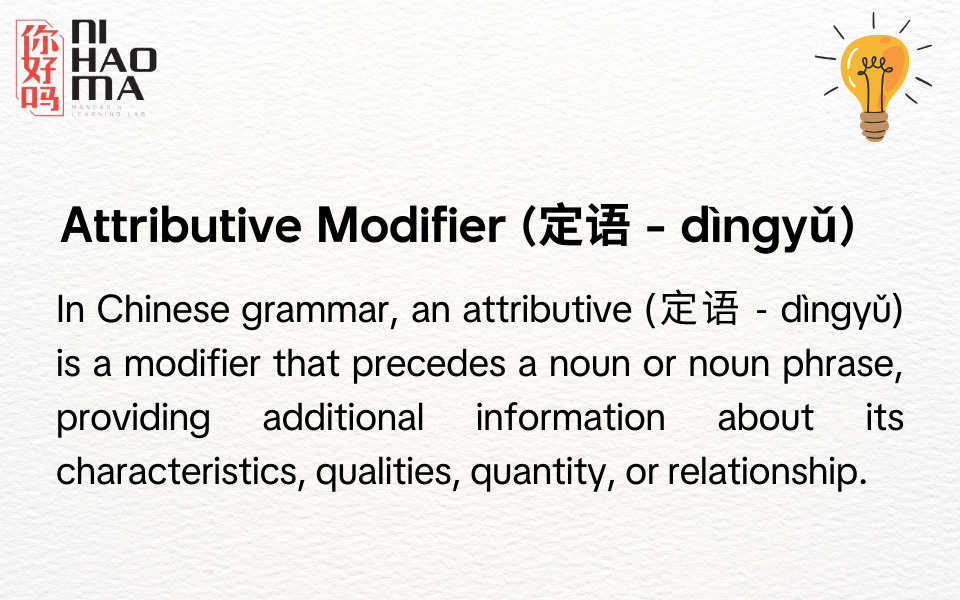
In Chinese, Chinese attributive modifiers always appear before the noun they modify, which is different from Vietnamese, where modifiers typically come after the noun.
For example:
- 漂亮的衣服。(piàoliang de yīfu) – A beautiful piece of clothing (“漂亮的” is the attributive modifier, and “衣服” is the main noun).
- 我的书。(wǒ de shū) – My book (“我的” is the attributive modifier, and “书” is the main noun).
Grammar of Chinese attributive modifiers
Chinese attributive modifiers are a crucial grammatical element in Chinese and are frequently used in both spoken and written language. Below are some essential points about attributive modifiers that you need to master:
Position of Chinese attributive modifiers
Chinese attributive modifiers always come before the noun they modify. This is a major difference from Vietnamese, where modifiers generally follow the noun. In most cases, the typical structure is:
Attributive modifier + 的 + Main noun
For example:
- 美丽的风景。(měilì de fēngjǐng) – Beautiful scenery.
- 我喜欢的书。(wǒ xǐhuān de shū) – The book that I like.

? Note: The particle “的” (de) is a structural particle frequently used to connect Chinese attributive modifiers to the main noun. However, in certain special cases, this particle can be omitted, as will be explained below.
The Structural Particle “的” (de)
In Chinese attributive modifiers, “的” (de) serves as a linking particle, connecting the modifier to the central noun. Nonetheless, there are situations where “的” can be omitted:
- When the attributive modifier is a single-syllable adjective, directly modifying the noun following it, the “的” is often left out.
Example: 好人 (hǎo rén) – a good person, 老朋友 (lǎo péngyou) – an old friend. - When the Chinese attributive modifier expresses quantity (such as “a few,” “several,” “one,” etc.), “的” is almost always omitted.
Example: 三个学生 (sān ge xuéshēng) – three students. - In spoken Chinese, if the attributive modifier refers to family members or close relationships, “的” can also be omitted.
Example: 我妈妈 (wǒ māma) – my mother, 我朋友 (wǒ péngyou) – my friend. - Additionally, in fixed phrases or specialized terms, the “的” is often unnecessary, as the phrase itself has become a set expression.
Example: 中文老师 (zhōngwén lǎoshī) – Chinese teacher, 北京人 (Běijīng rén) – Beijinger.
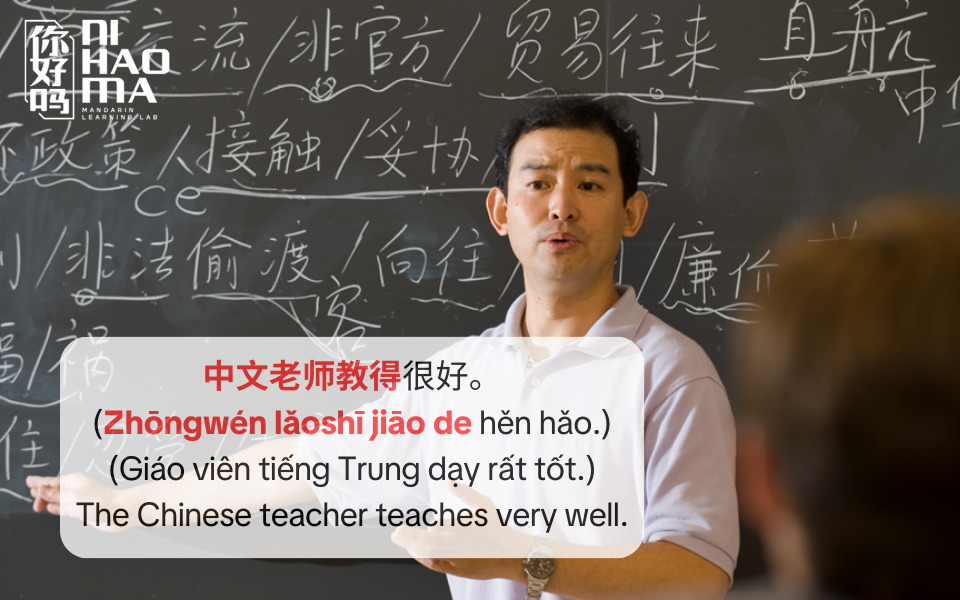
Sentence Structure with Chinese Attributive Modifiers
When Chinese attributive modifiers appear in a complete sentence, they typically occur within a noun phrase, which may function as the subject, object, or another element in the sentence. The general sentence structure with Chinese attributive modifiers can be summarized as:
Subject + Predicate + Object (with an attributive modifier)
Example:
我喜欢漂亮的衣服。(Wǒ xǐhuān piàoliang de yīfu.)
I like beautiful clothes.
In this sentence:
- 我 (wǒ): Subject
- 喜欢 (xǐhuān): Predicate (Verb)
- 漂亮的衣服 (piàoliang de yīfu): Object with an attributive modifier
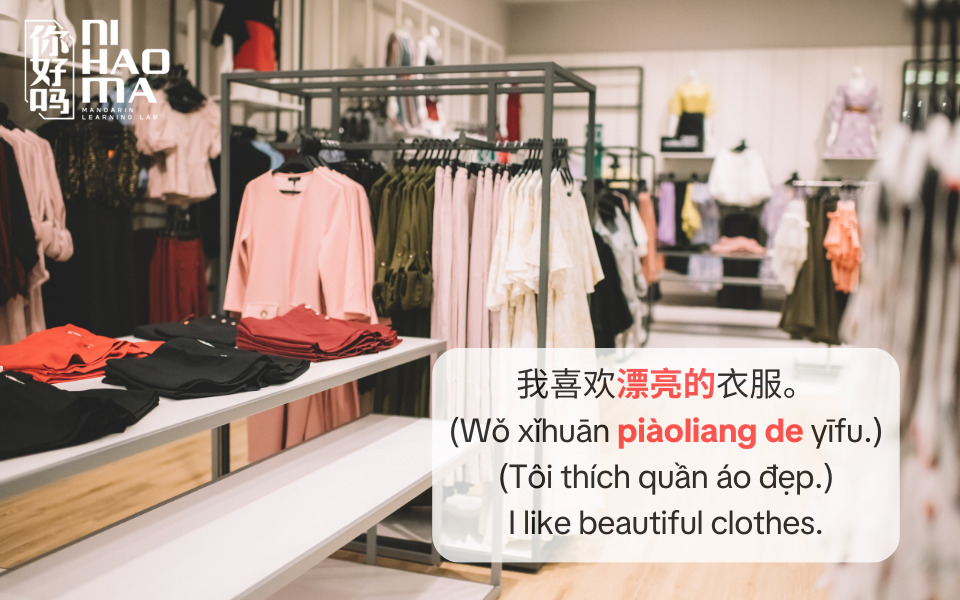
Chinese attributive modifiers can also appear in more complex sentence structures, such as:
- Attributive clause as a relative clause:
我买的书。(wǒ mǎi de shū) – The book that I bought. - Embedded attributive modifier:
我妈妈送给我的漂亮的衣服。(wǒ māma sònggěi wǒ de piàoliang de yīfu) – The beautiful clothes my mother gave me.
Types of Chinese Attributive Modifiers
Depending on the nature of the modifier, Chinese attributive modifiers can be classified into several types. Below are the main types, with examples to illustrate their use and purpose:
Descriptive Attributive Modifiers (描述性定语)
Descriptive attributive modifiers are used to describe the characteristics, attributes, states, or properties of the noun they modify. These modifiers help the listener or reader form a clearer picture of the noun, answering the question: “What is it like?” or “What are its characteristics?”
Examples:
- 漂亮的女孩。(piàoliang de nǚhái) – A beautiful girl.
- 很大的房子。(hěn dà de fángzi) – A very large house.
- 旧书。(jiù shū) – An old book (with “的” omitted).
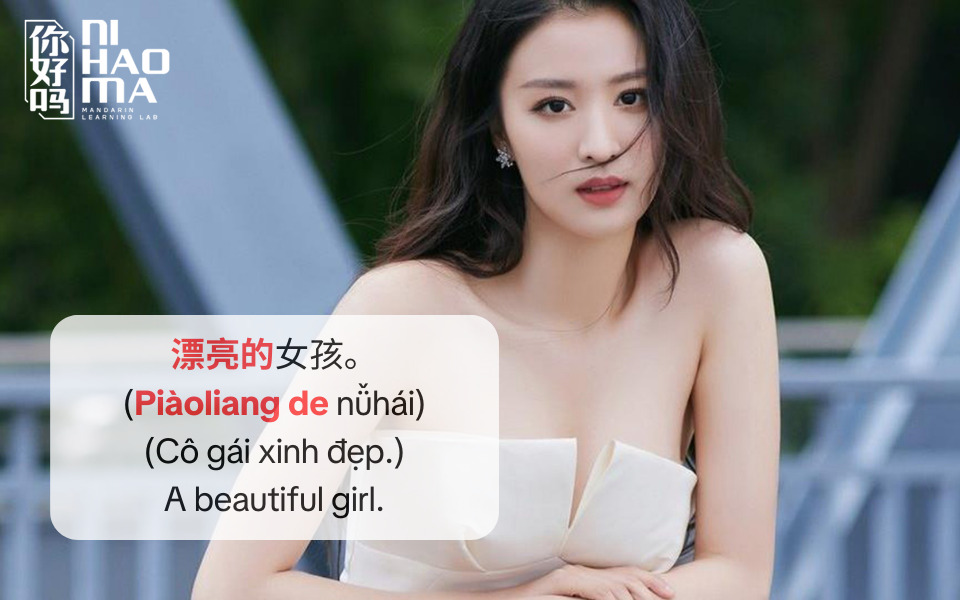
Structural Attributive Modifiers in Chinese (结构性定语)
Chinese attributive modifiers can take the form of structural attributive modifiers, which are created from phrases, verb phrases, or even subject-predicate structures. This type of modifier provides more detailed information about the noun it modifies, often describing actions, states, or relationships related to the noun.
A structural attributive modifier is not just a single word, but a grammatically structured phrase. Typically, these modifiers are connected to the main noun using the structural particle “的” (de).
Examples:
- 吃苹果的孩子。(chī píngguǒ de háizi): the child who eats apples.
- 我妈妈做的饭。(wǒ māma zuò de fàn): the food cooked by my mother.
- 他写的文章。(tā xiě de wénzhāng): the article he wrote.
Restrictive Attributive Modifiers in Chinese (限制性定语)
Another important type of Chinese attributive modifiers is the restrictive attributive modifier, which functions to narrow down, specify, or define the scope, quantity, or characteristics of the modified noun. In other words, restrictive modifiers help distinguish the noun from other nouns of the same type.
Examples:
- 我有两本书。(Wǒ yǒu liǎng běn shū.) – I have two books (limiting the number of books).
- 我的电脑坏了。(Wǒ de diànnǎo huài le.) – My computer is broken (limiting which computer is referred to).
- 昨天买的衣服很漂亮。(Zuótiān mǎi de yīfu hěn piàoliang.) – The clothes bought yesterday are beautiful (limiting by purchase time).
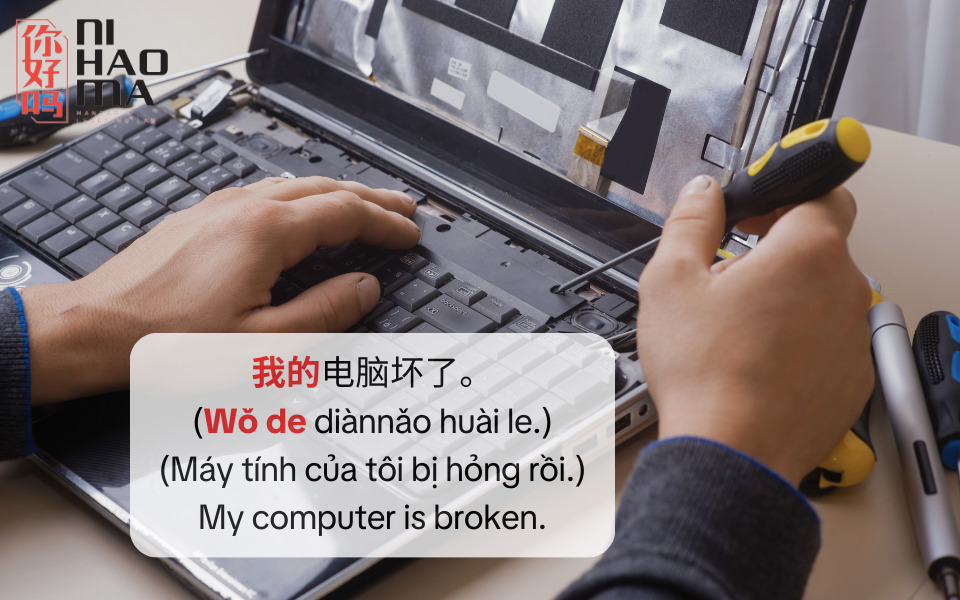
Common Forms of Chinese Attributive Modifiers
In Chinese, any word or phrase that adds clarity or meaning to a noun can function as a Chinese attributive modifier. These modifiers come in many forms:
1. Nouns as Attributive Modifiers
Nouns can act as Chinese attributive modifiers, adding information about ownership, origin, or related fields. When the modifier is a noun representing a country, region, organization, or specialized field, “的” is often omitted.
Examples:
- 妈妈的书。(māma de shū) – Mom’s book.
- 中国文化。(zhōngguó wénhuà) – Chinese culture (no “的”).
- 学校图书馆。(xuéxiào túshūguǎn) – School library (no “的”).
2. Adjectives as Attributive Modifiers
Adjectives describe qualities or characteristics of the noun. When used as Chinese attributive modifiers, adjectives usually require “的” afterward.
Examples:
- 漂亮的衣服。(piàoliang de yīfu) – Beautiful clothes.
- 聪明的学生。(cōngmíng de xuéshēng) – Smart student.
- 便宜的手机。(piányi de shǒujī) – Cheap phone.
3. Pronouns as Attributive Modifiers
Pronouns (I, you, he, we…) can act as Chinese attributive modifiers to show possession. When pronouns serve this function, “的” is mandatory.
Examples:
- 我的书。(wǒ de shū) – My book.
- 你的老师。(nǐ de lǎoshī) – Your teacher.
- 他们的家。(tāmen de jiā) – Their house.

4. Numbers as Attributive Modifiers
Numerals combined with measure words can also function as Chinese attributive modifiers to specify quantity. In this case, “的” is unnecessary.
Examples:
- 三本书 (sān běn shū) – Three books.
- 两个孩子 (liǎng gè háizi) – Two children.
- 五个苹果 (wǔ gè píngguǒ) – Five apples.
5. Verbs as Attributive Modifiers
Verbs or verb phrases can also act as Chinese attributive modifiers, adding information about actions related to the noun. In this case, “的” is required.
Examples:
- 我买的书。(wǒ mǎi de shū) – The book I bought.
- 老师推荐的电影。(lǎoshī tuījiàn de diànyǐng) – The movie recommended by the teacher.
- 他写的信。(tā xiě de xìn) – The letter he wrote.
Additional Notes on Using Chinese Attributive Modifiers
Chinese attributive modifiers play a critical role in Chinese grammar, enriching sentences with essential descriptive or defining details. To use them correctly and naturally, here are a few important points to remember:
Attributive Clauses in Chinese
An attributive clause (where a full clause with a subject and predicate functions as an attributive modifier) is a common structure in Chinese. In such cases, “的” is always required to link the clause to the noun.
Examples:
- 我朋友送的礼物。(wǒ péngyǒu sòng de lǐwù) – The gift my friend gave.
- 他昨天看的电影。(tā zuótiān kàn de diànyǐng) – The movie he watched yesterday.
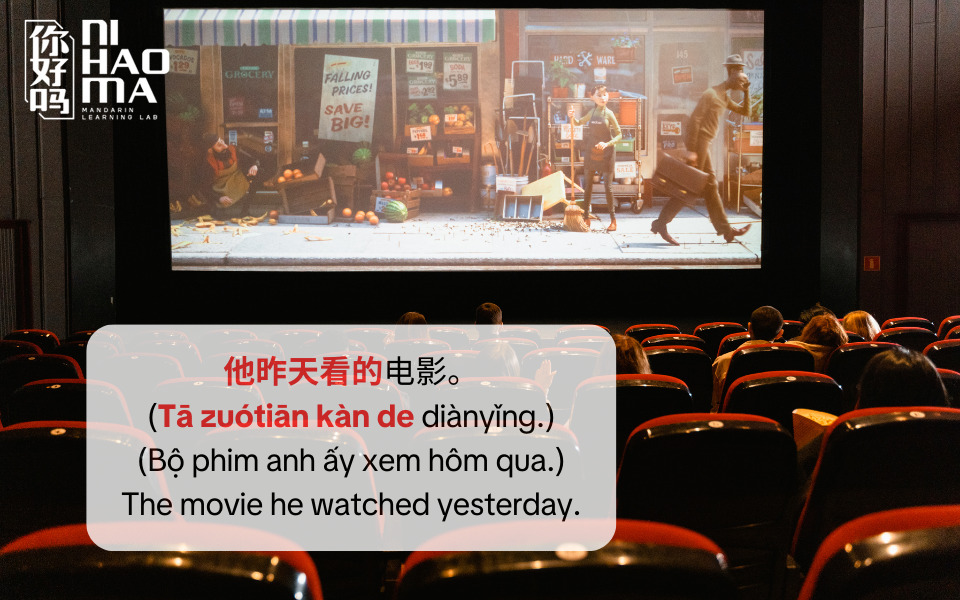
Nouns with Multiple Attributive Modifiers
When a noun has multiple Chinese attributive modifiers, they follow a specific order:
Owner → Scope/Quantity → Quality/Characteristic → Origin/Source → Main Noun
Example:
- 妈妈送我的漂亮的裙子。(Māma sòng wǒ de piàoliang de qúnzi) – The beautiful dress my mom gave me.
- 我的三本新书。(Wǒ de sān běn xīn shū) – My three new books.
Distinguishing Attributive Modifiers from Complement Modifiers
Learners of Chinese often confuse Chinese attributive modifiers (定语) with complement modifiers (补语), because both can use adjectives or phrases to add detail. However, the key difference lies in position and grammatical function.
- Chinese attributive modifiers appear before the noun they modify, describing attributes, properties, or relationships.
- Complement modifiers appear after the verb, describing results, states, degrees, or manners of the action.
Examples:
- 漂亮的衣服 (piàoliang de yīfu) – Beautiful clothes (漂亮的 as attributive modifier).
- 她穿得很漂亮 (tā chuān de hěn piàoliang) – She dressed beautifully (漂亮 as complement modifier).
Related Articles:
- What are Pronouns in Chinese? Classification and Usage
- Prepositions in Chinese: Classification and Notes
- 100 Common Verbs in Chinese
Conclusion
Mastering Chinese attributive modifiers is essential for both written and spoken Chinese, as they allow you to add nuance, clarity, and precision to your language. Understanding the types, structures, and rules surrounding Chinese attributive modifiers will not only enhance your grammar knowledge but also greatly improve your ability to express complex ideas naturally.
We hope this guide has provided valuable insights into Chinese attributive modifiers—stay tuned for more helpful lessons from Ni Hao Ma!
